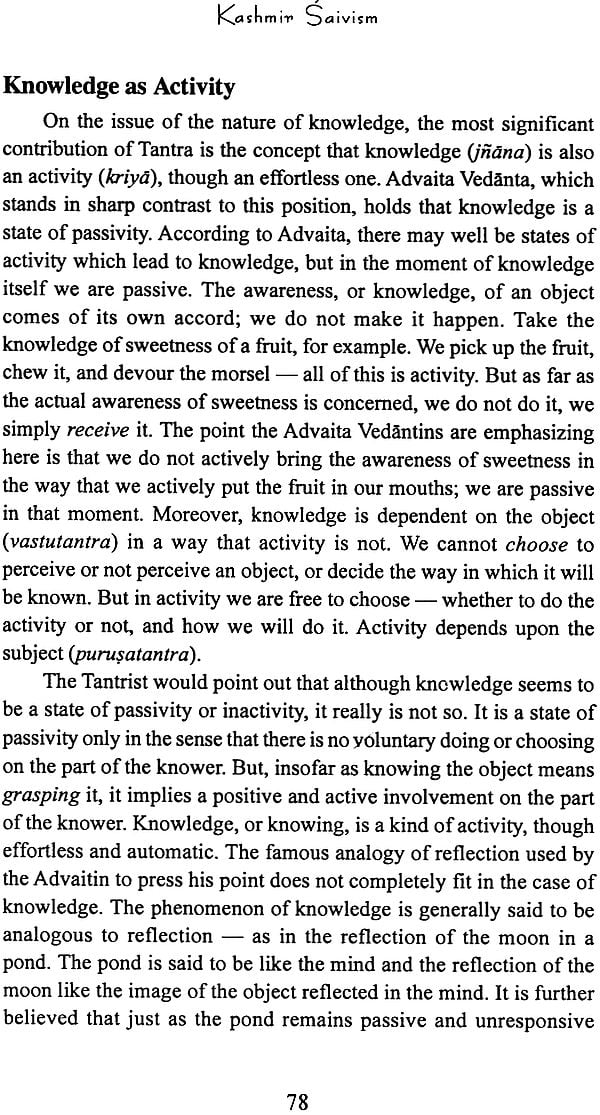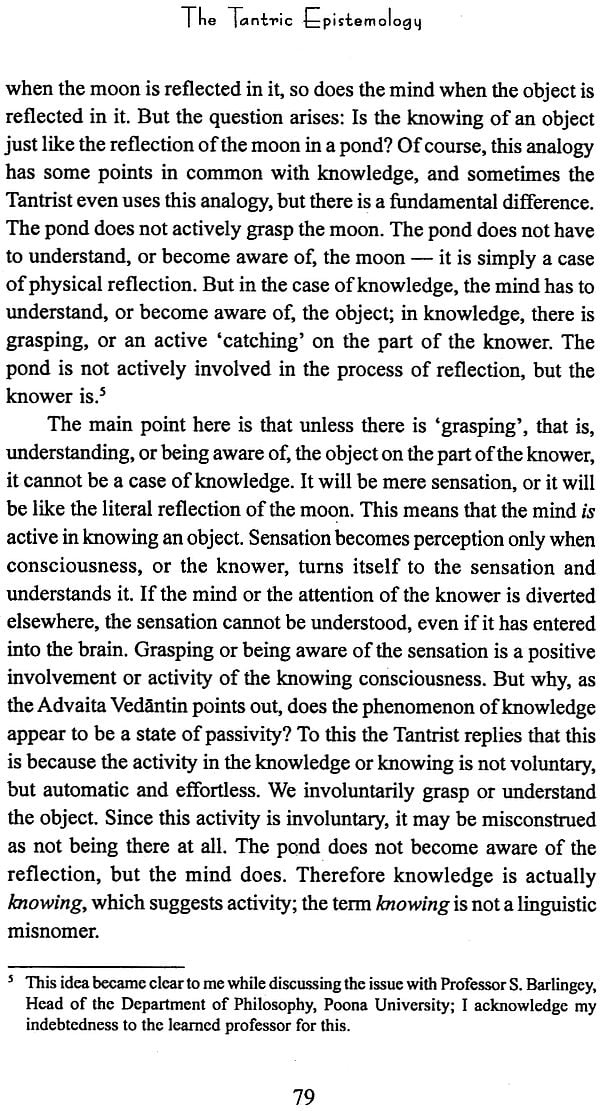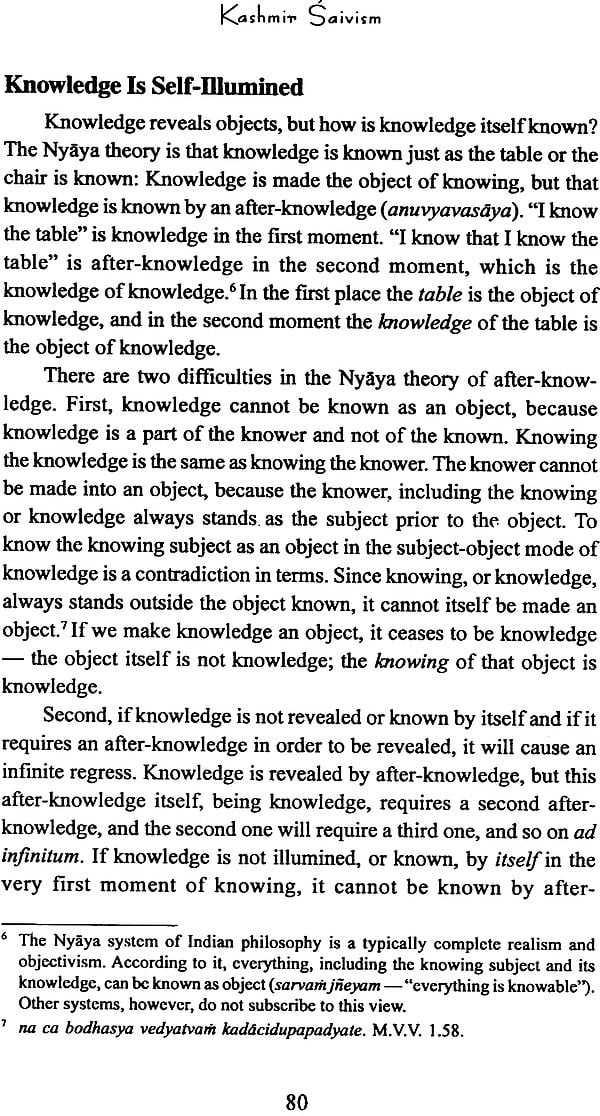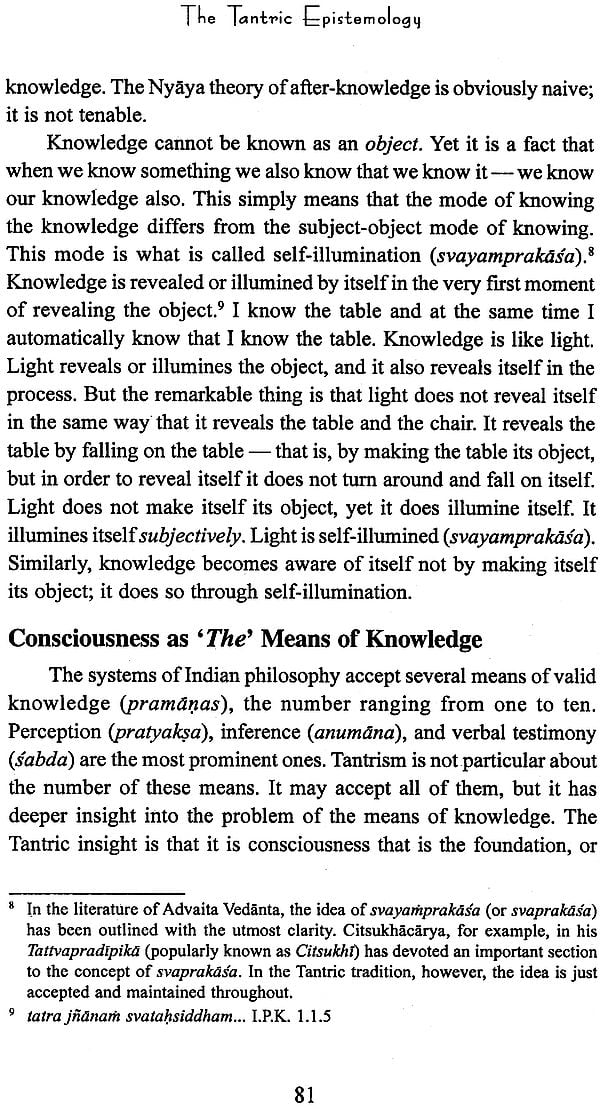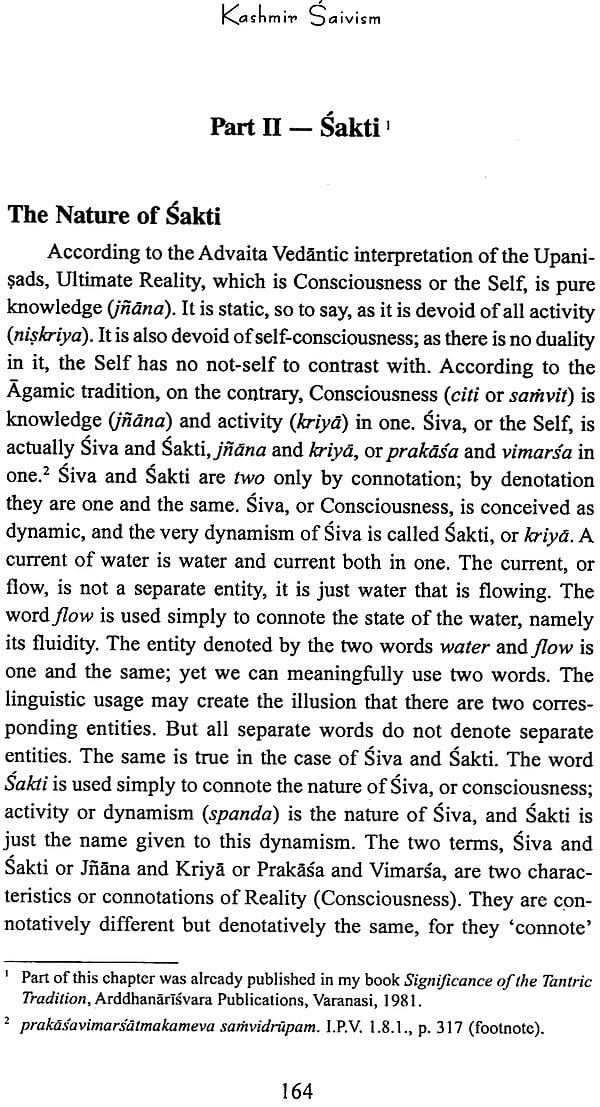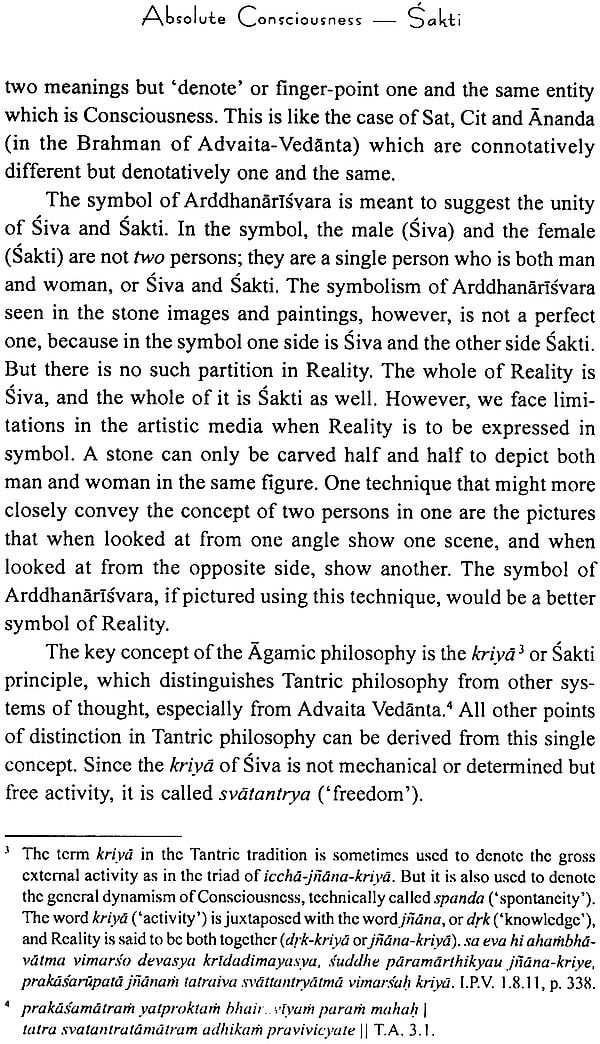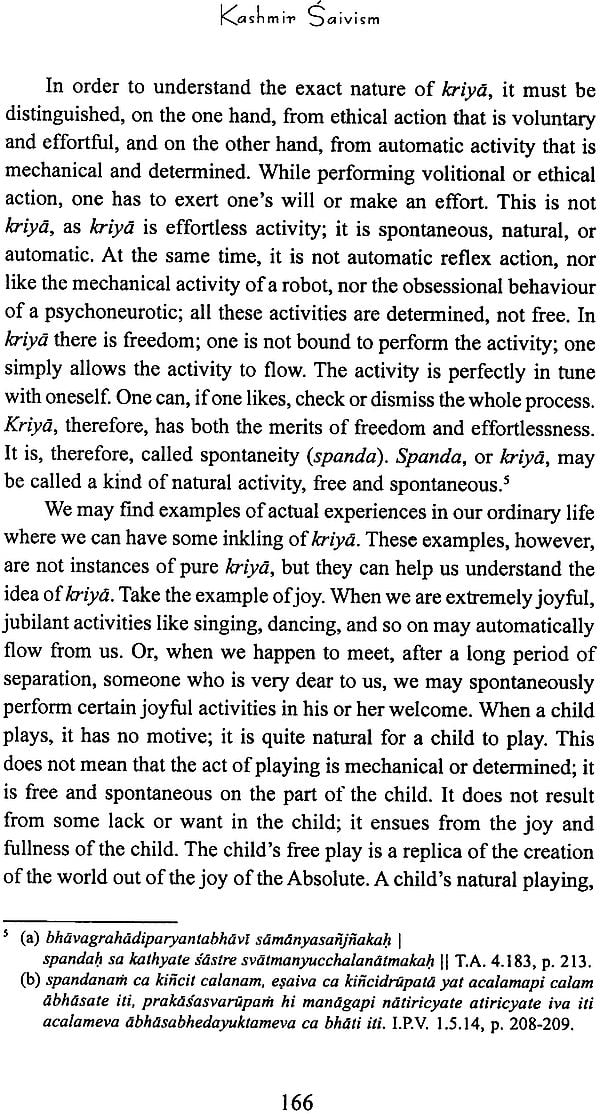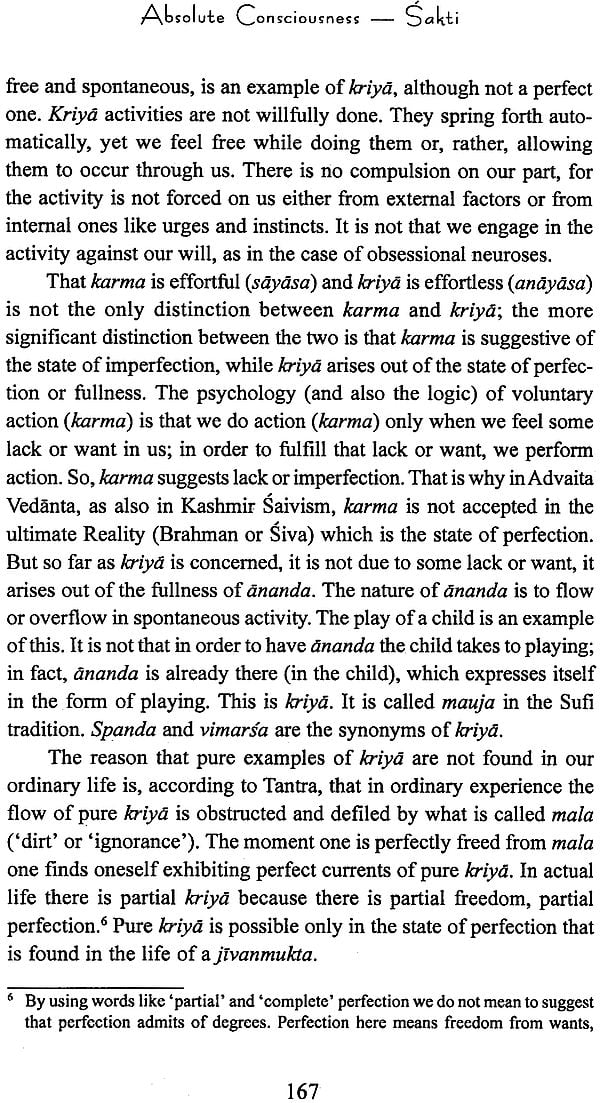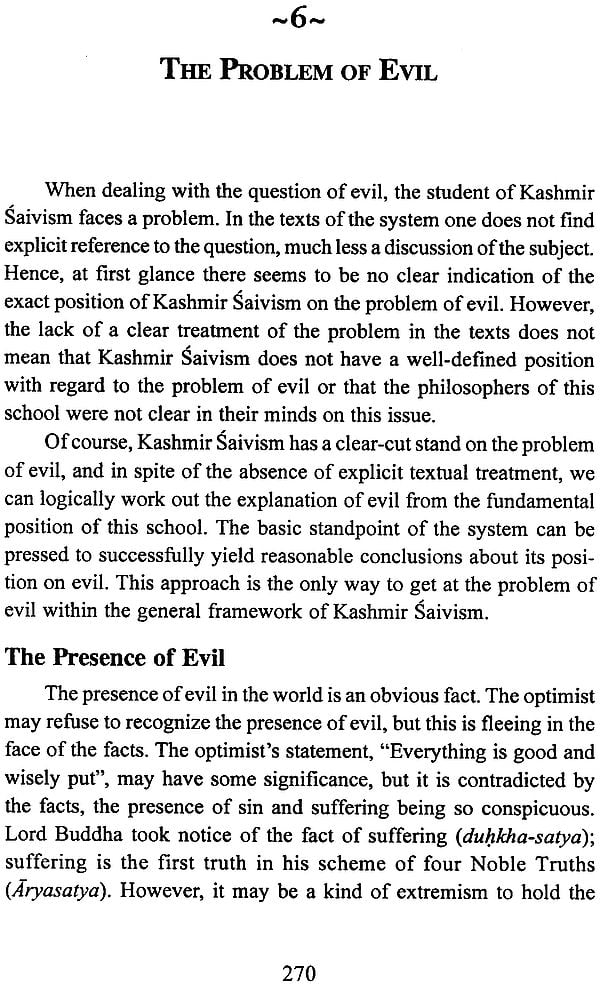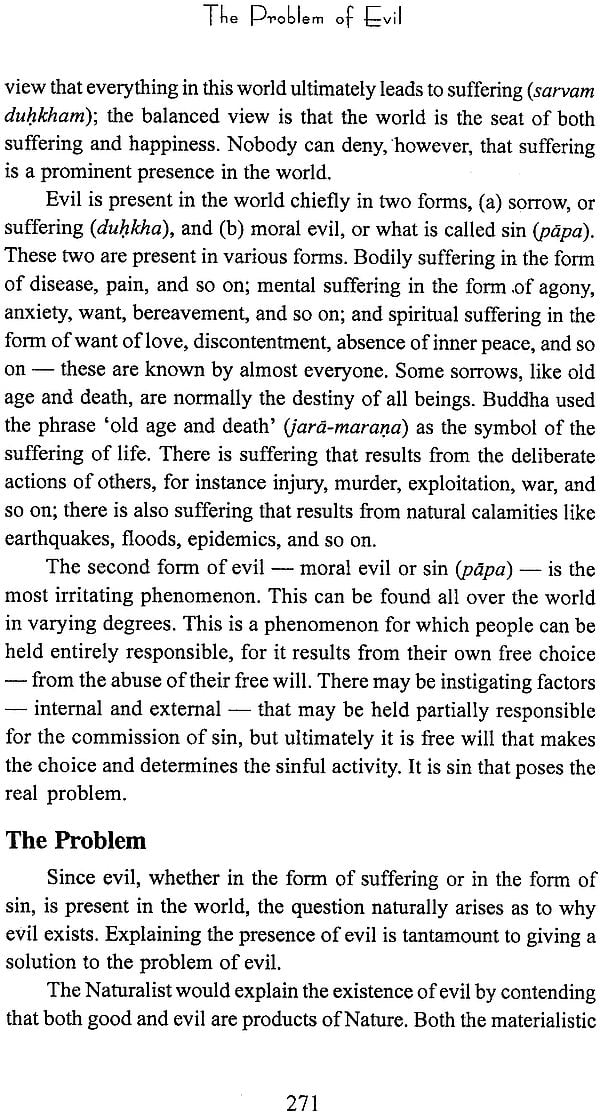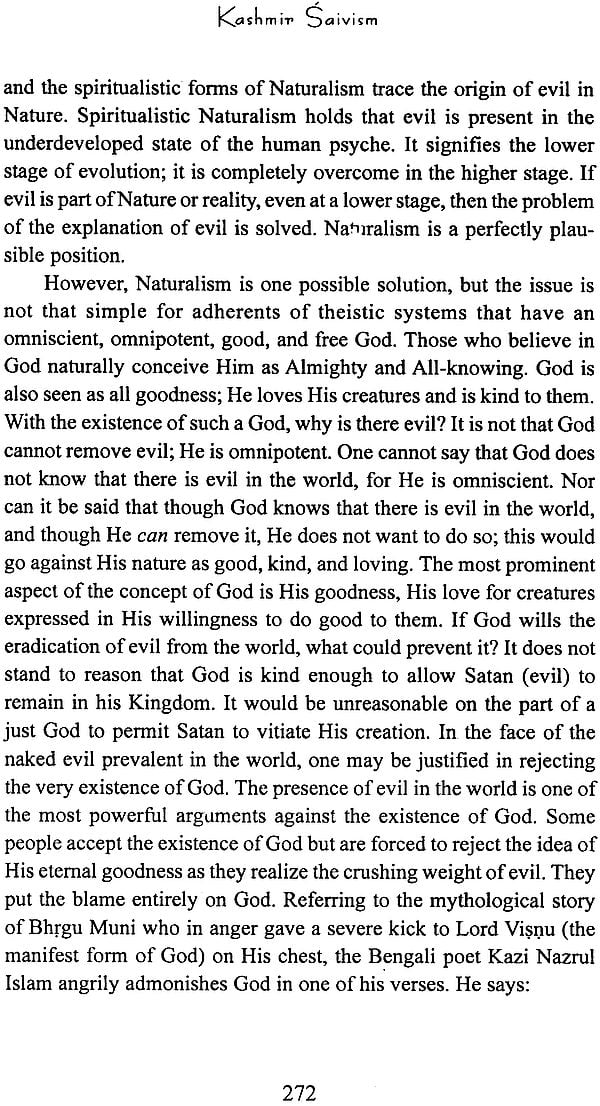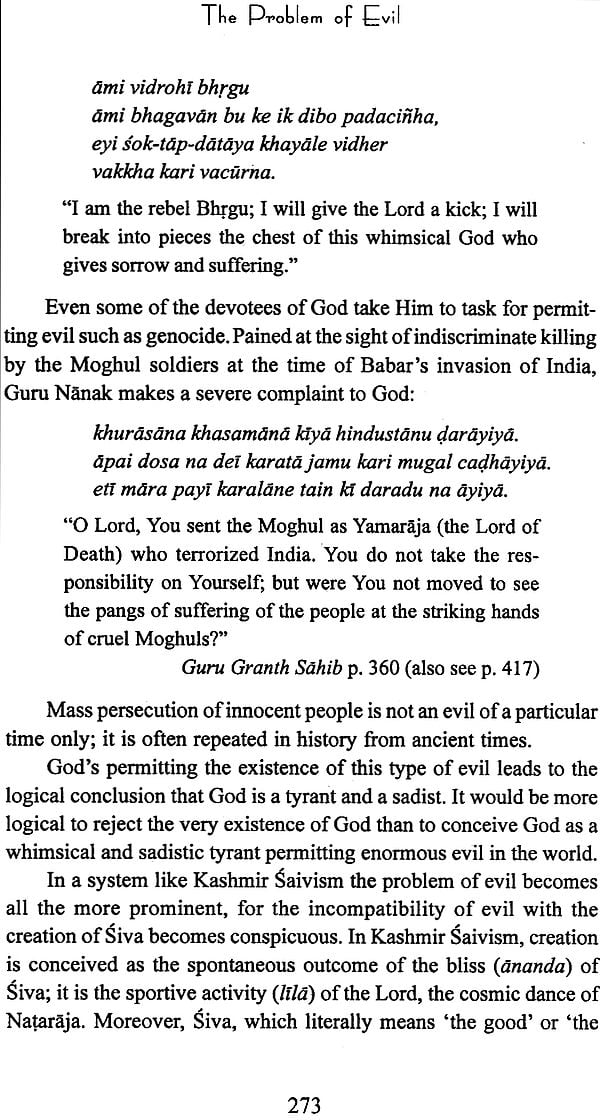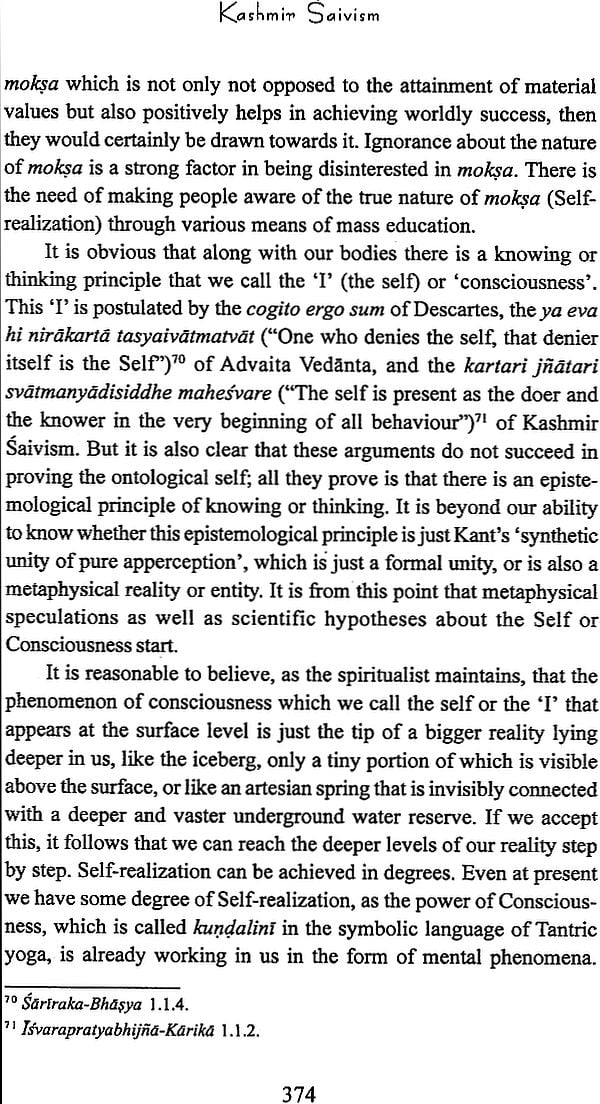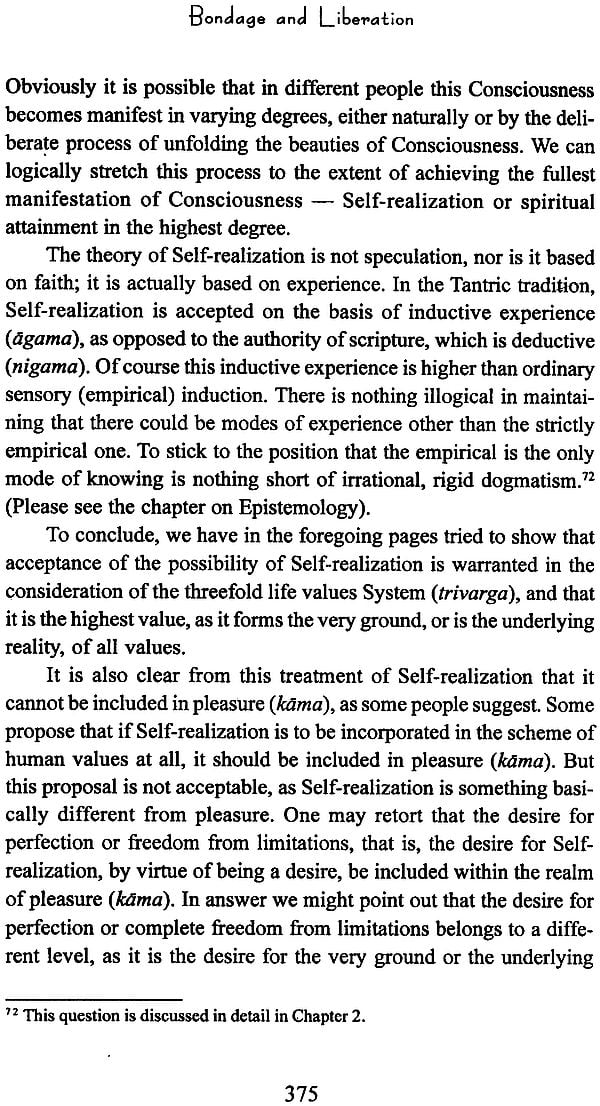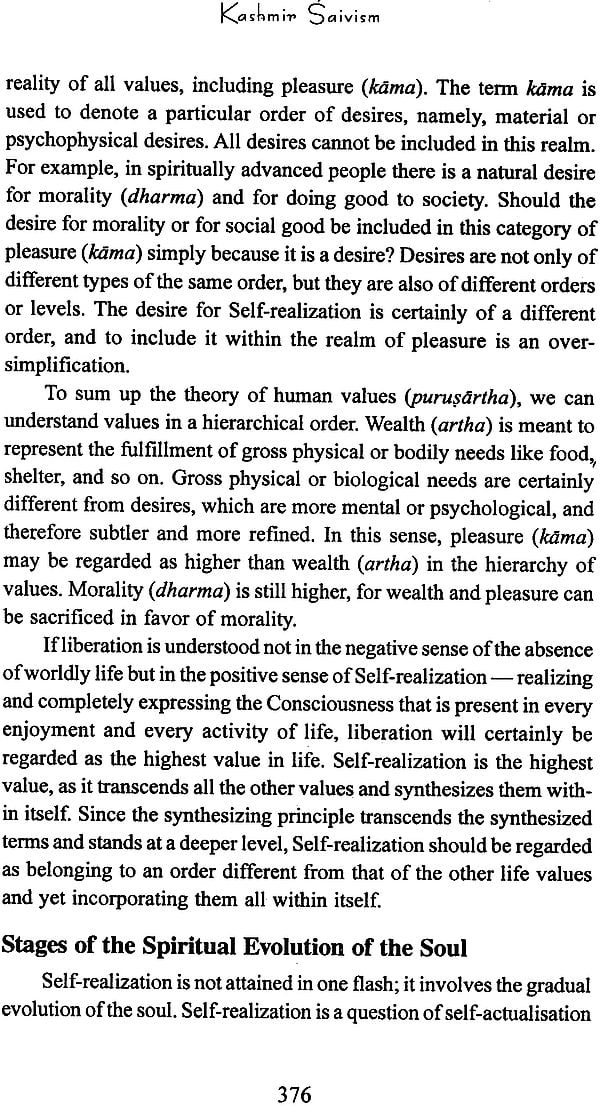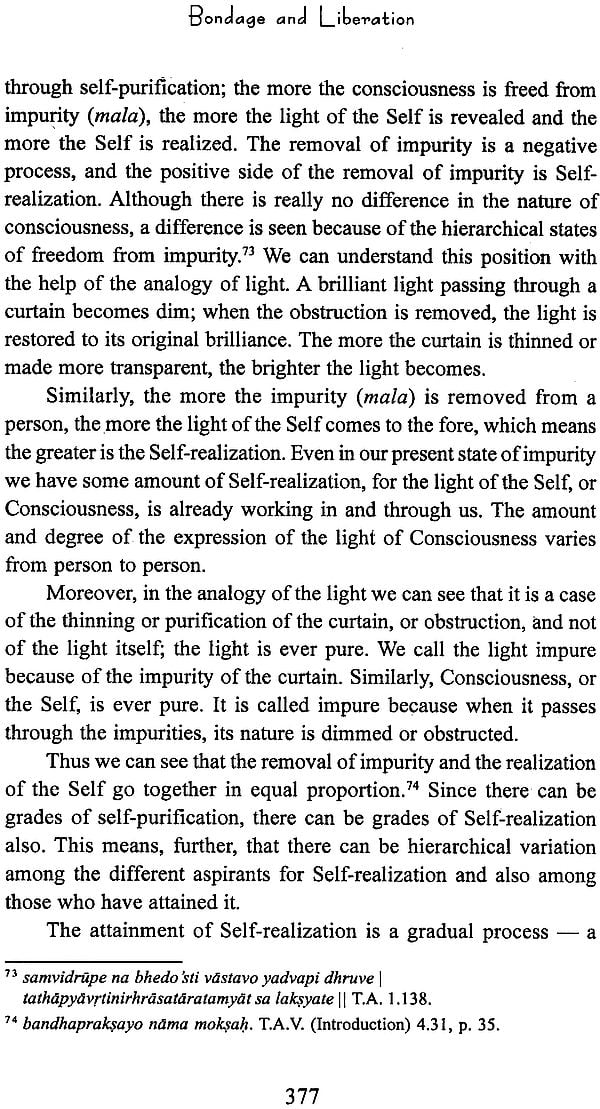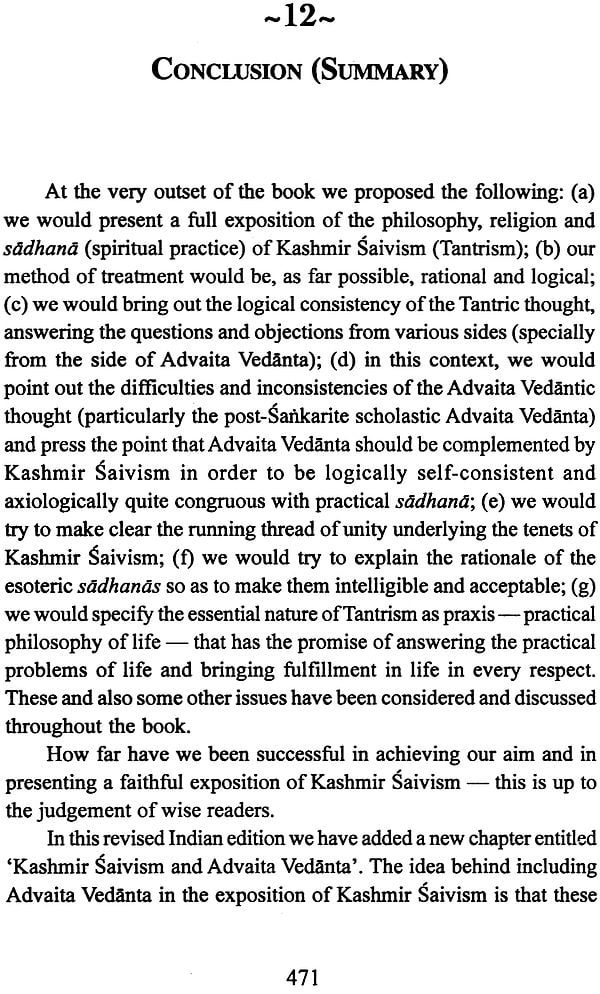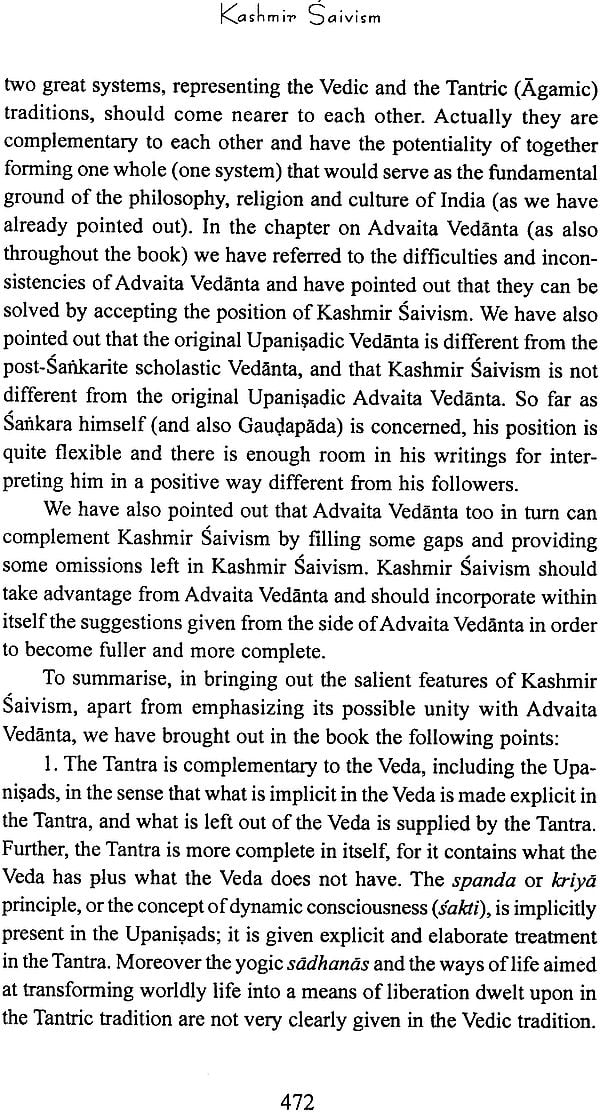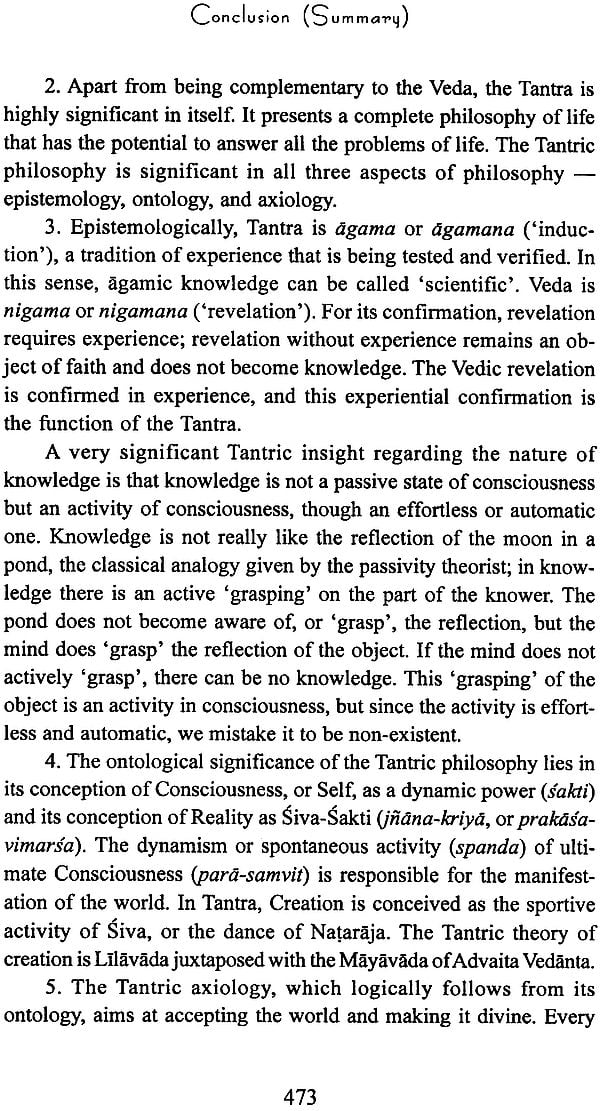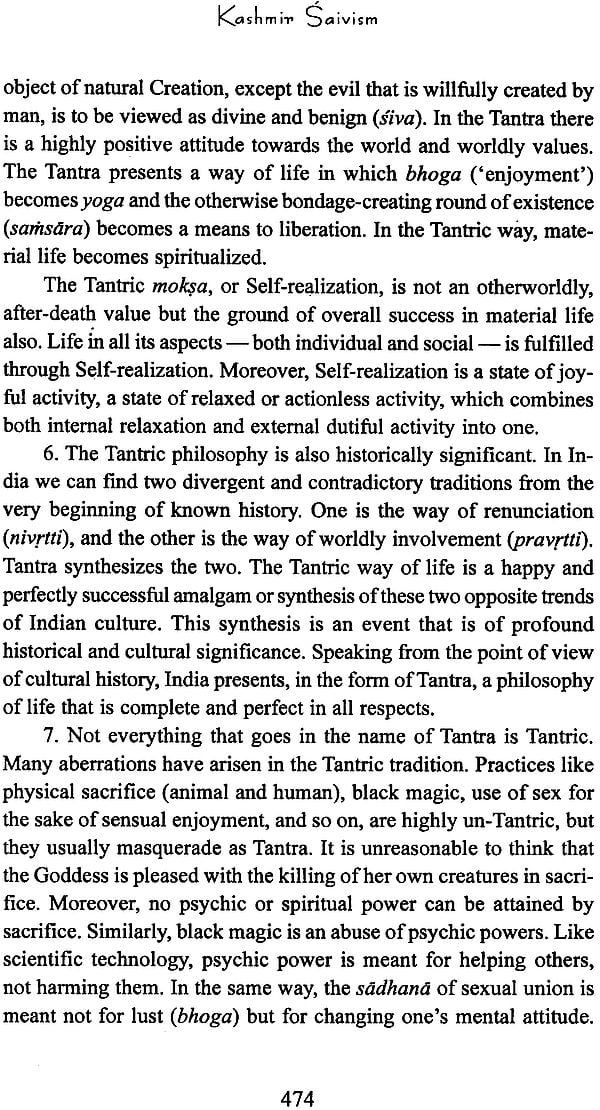
Kashmir Saivism – The Central Philosophy of Tantrism
Book Specification
| Item Code: | NAC688 |
| Author: | Kamalakar Mishra |
| Publisher: | Indica Books, Varanasi |
| Language: | English |
| Edition: | 2011 |
| ISBN: | 9789381120033 |
| Pages: | 504 |
| Cover: | Hardcover |
| Other Details | 8.8 Inch X 5.8 Inch |
| Weight | 700 gm |
Book Description
Dr. Mishra’s comprehensive book is learned without being tedious; philosophical without being intellectually arid; and readable without being banal. Above all, it preserves the aroma of spiritual practice that is fundamental to the Pratyabhjna tradition. Anyone interested in the metaphysics of spiritual practice or in Yoga and Tantrism will read this book with immense profit.
— Georg Feuerstein, Ph.D. (Author of Encyclopaedic Dictionary of Yoga)
In this work Mishra discusses the central themes woven throughout the whole of the Tantric system, making it accessible, practical, and inspiring as a means to self-realization. This book would be excellent reading for students of the Tantric tradition and philosophy.
—NAPRA Trade Journal
Thorough exposition of the Tantric system... A full exploration of Kashmir Saivism’s history and the special significance of Abhinavagupta whose brilliant and encyclopedic works established Kashmir Saivism as an important philosophical school. Extensively referenced with notes to the text for source data or detailed elaboration.
—Hinduism Today
A brilliant exposition of Tantric tradition... Mishra profoundly explains a system which allows us to fully integrate spiritual inquiry and practice with the mundane goals of physical enjoyment [and] worldly involvement. For spiritual seekers of any sort, with a true interest in understanding the nature of Tantra... this book will finally provide true insight into the ways and means of Tantric philosophy.
—New Age Retailer
Kamalakar Mishra, Ph.D., is a retired professor of the Department of Philosophy and Religion at Banaras Hindu University in Varanasi, India. He is also the author of The Sign 7icance of the Tantric Tradition.
The first and the second editions of the book were published by Rudra Press (Portland, U.S.A.) in 1993 and 2009, respectively. But unfortunately innumerable printing mistakes remained in the second edition. So, it was decided to bring out a new edition after correcting the mistakes of the earlier edition and also after revising it again in the light of questions and comments from the side of the learned readers. Indica Books (Varanasi, India) volunteered to publish the new (third) edition.
A few points may be mentioned with regard to the special contribution of this Indica Books edition. First, documentation references were given in the earlier edition as endnotes, but in the present edition they are given as footnotes. Although this involved an added effort on the part of the publisher, it was done for the convenience of the reader. Second, a new chapter entitled “Kashmir Saivism and Advaita Vedanta” has been added. Advaita Vedanta and Kashmir Saivism are the two most prominent systems of the Vedic and the Tantric tradition, respectively. They are complementary to each other, and together they present a complete picture of the philosophy, religion and culture of India. So the need is to bring out the cumulative wisdom of these two systems and make an in-depth analysis of their positions so that their ‘two-in-one’ position becomes cleat Although throughout the book the position of Advaita Vedanta is considered vis-à-vis that of Kashmir Saivism, we have tried to make the picture all the more clear in this added chapter.
Third, I have tried to answer the questions put forth from the side of the readers. I have also tried to meet the criticism made by an enlightened reader about the ‘scientific status’ of the Tantric knowledge (criticism published inAmazon.com). I have received a lot of questions from the readers the world over. It was not possible for me to answer the questions individually, but the present revised edition covers their questions.
Many readers (specially from the West), after reading the chapter entitled “The Left-handed Doctrine (Kaula-sadhana) and sex- sublimation”, have requested me to present a more explicit and detailed account of the sadhana related to sex. My submission here is that knowledge of the secret leftist spiritual sadhana of sex-sublimation is imparted from teacher to pupil privately, yet it is possible to some extent to explain the fundamentals of the leftist way together with tips for practical guidance. With the awareness of this demand in my mind, I am writing a book under the heading “Spiritual Foundations of Sex-education”, which I hope will meet the demand to some extent.
I take this opportunity to express my thanks to the readers who have appreciated and praised the book. I have received innumerable e-mails and telephone calls from my readers all over the world expressing their gratitude to me, saying they have been greatly benefited from reading the book. Some of them have praised the book in a superlative way. I am also thankful to the reviewers who have expressed their appreciation for the book. I myself am greatly benefited by the feedback I have received from the readers and reviewers. The feedback has helped me come out with an improved edition.
I am specially thankful to M/s Indica Books who have taken great pains in publishing the book. In the beginning I had suggested to them that the book be just re-printed giving a list of errata, but they were generous enough to take the trouble of re-typing, re-setting and publishing it all anew. Dilip Kumar Jaiswal, of Indica Books, has been very kind and co-operative. I am also thankful to the editor of Indica Books, Alvaro Enterria, who examined the text very carefully and gave me many helping suggestions.
The present work is an exposition of the philosophy and religion of the Trika system, popularly known as Kashmir Saivism. Kashmir Saivism is the most prominent system of the Tantric tradition. I consider Kashmir Saivism the true or central philosophy of Tantrism.
My earlier book, Significance of the Tantric Tradition (1981, Varanasi, India), has much in common with the present work, but was written with a different objective in mind. The objective of Significance of the Tantric Tradition, as the title suggests, was not to present a full exposition of Tantric philosophy but to point out the significance of this philosophy from various angles — historical, epistemological, ontological, and axiological. The book’s primary aim was to bring out the consistency and authenticity of Tantric thought and to make explicit the running thread of logic implicit in the system. The present work, Kashmir Saivism: The Central Philosophy of Tantrism, however, is meant to be a full exposition of the Tantric system, covering all areas of Tantric philosophy. As such, it contains many topics not previously discussed and can be viewed as un elaboration of the earlier work.
Although the contribution of Tantra to Indian philosophy and culture is of immense significance, little work has been done in this field. Moreover, the Tantras, or Agamas, have something significant and relevant to say to modem humanity. With its positive attitude towards the world and its variety of yogic cadhanas for self- improvement in all respects, Tantra carries a promise of help to people iii their present predicament. This makes exposition and elucidation o Tantric insight worthwhile.
The mystic language of the Tantras and the rich symbolism found (herein present difficulties in the exposition of Tantric thought. Abhinavagupta, the principal philosopher of Kashmir Saivism, overcame these difficulties in making a systematic and rational presentation of Tantric wisdom in his famous work, the Tantraloka. This present book is an attempt to understand the Tantric position mainly in light of the Tantraloka.
Although Abhinavagupta seems to have unraveled the knots of Tantric philosophy and religion, much is left, even in his works, to be further clarified and elaborated. This is why differences of opinion and confusion exist among Tantric scholars with regard to the correct position of Tantric thought. My goal in the present work is to spell out implicit ideas, to make explicit the inner thread of logic of the Tantric system, and to fill in the gaps when possible.
In this attempt, some views might emerge that will appear new and original to the reader. But I submit that nothing is really new; everything is present, perhaps merely implicitly, in the Tantric position. For example, I have tried to present the rationale or the underlying logic of the left-handed (vama or Kaula) doctrine, specifically with regard to sex. I have also interpreted and presented Tantric religion, or the Tantric way of life, in such a way as to make it quite relevant to the modem age of science and technology. All of this might seem to be my own invention, but actually it can be clearly read between the lines in the Tantras; I have simply tried to make it more explicit. What may at most be considered my own contribution is my attempt to supply the apparently missing links. But that, too, is purely on the basis of the Tantric thought.
In this book, I attempt to present a logical analysis of the Tantric position of Abhinavagupta. I have also shown, according to my understanding, what remains unresolved and unanswered in his philosophy, but I admit that in the present work I am mainly playing the role of advocate of Abhinavagupta rather than critic. I am trying (a) to justify the Tantric position from the rational point of view, (b) to work out a consistent philosophy of Kashmir Saivism, (e) to present the rationale of the abstruse Tantric sadhanas, (d) to trace out and clarify the inner thread of logic running through the entire system of thought, and (e) to demonstrate the soundness and significance of Kashmir Saivism.
At places in my discussion the Advaita Vedantin appears as the chief opponent (purvapaksin) of Tantra, for the simple reason that some of the basic principles of the Tantric system are questioned and contradicted by Advaita Vedanta. In defense, the Tantrist would not only justify him but would in turn counter-question the Advaitin. My aim at those places is not to enter into polemics and refute the Advaitin but simply to clarify my own position. I hope the Advaita Vedantins will take my criticisms in that spirit.
Regarding the attitude of the Kashmir Saiva philosophers towards Advaita-Vedanta, one more thing need be made clear. Kashmir Saivites maintain that the original Advaita Vedanta present in the Upaniads, and not in the commentaries on the Brahma-sutras, is similar to Tantra. They agree with the Upaniads but differ from the Sankarite interpretation of the Upaniads (especially the post Sankarite Advaita scholasticism), which according to them is not in line with the main spirit of the Upaniads. There is an implicit claim among them that the Advaitic philosophy can be made logically consistent and practically useful only when it is complemented by Kashmir Saivism.
The present work is the result of long years of study, research, thinking, and discussion on the subject. In expounding the topic, I have attempted to apply the utmost clarity of thought and explain the abstruse ideas in a simple way. The style of presentation is more like that of a teacher explaining and discussing things in an informal way than that of a pedant heavy with the weight of scholarship.
Moreover, Kashmir Saivism is, to borrow a term from existentialism, a praxis — an authentic philosophy, not a mere ideology. Therefore, I have tried to present it in such a way as to impress upon the reader that this philosophy is related to life and is something of real concern. I have taken care not to be abstract in my treatment of this philosophy so that it does not lose touch with life.
In order to avoid misunderstanding and misinterpretation and to make the issues clear, I have also at times made certain repetitions. I submit that the repetitions cannot be helped, or can be avoided only at the cost of clarity and completeness of understanding. Sometimes repetitions are made also to lay extra emphasis on the point. Moreover, the repetitions are of a few words or a few sentences only, and will, I hope, be excused by the reader.
One more submission for clarification. In the literary tradition, in places where a pronoun is to be used to suggest both masculine and feminine genders, the practice has been to use the masculine one (for example, ‘he’ for both ‘he’ and ‘she’, or ‘his’ for both ‘his’ and ‘her’, or ‘man’ for both ‘man’ and ‘woman’). But owing to feminist awareness and recognition of gender equality, some writers nowadays have started using expressions like ‘he or she’, ‘his or her’, ‘himself or herself’ and soon. But this may look like an unnecessary elaboration and also may look odd. So I have followed the traditional way of using ‘man’ for both man and woman. However, as for myself I am a Tantrist worshipper and consider woman superior to man. Left to myself, I would like to write ‘she’ for both ‘she’ and ‘he’. But because the literary tradition is otherwise, this may become confusing to the reader.
| Acknowledgments | v | |
| Preface to the Third (Revised and Enlarged) Edition | 11 | |
| Preface | 13 | |
| Acknowledgments | 17 | |
| Abbreviation | 19 | |
| 1. Introduction | 21 | |
| General Significance o the Tantric Tradition | 21 | |
| History of the Tantric Tradition | 32 | |
| Amalgamation of the Cultures of Renunciation (nivrtti) and Worldly Involvement (pravrtti) | 35 | |
| The Tantric Denominations | 38 | |
| The Common Features | 41 | |
| Significance of the Left-Handed Doctrine (Kaula-marga) | 44 | |
| Breaking False Barriers | 47 | |
| Aberrations in Tantra | 49 | |
| Kashmir Saivism as the Culmination of Tantric Philosophy | 51 | |
| The Etymology of Tantra and Agama | 57 | |
| The Textual History | 58 | |
| The Special Significance of Abhinavagupta | 67 | |
| 2. The Tantric Epistemology | 73 | |
| The Problem of Consciousness | 74 | |
| Knowledge as the Nature of Consciousness | 76 | |
| Knowledge as Activity | 78 | |
| Knowledge is Self-illumined | 80 | |
| Consciousness as ‘The’ Means of Knowledge | 81 | |
| Consciousness Self-illumined | 85 | |
| Agamic Knowledge | 88 | |
| Is Agamic Knowledge Scientific? | 92 | |
| Objections to Agama-pramana | 102 | |
| The Limits of Knowledge | 108 | |
| What is Higher Experience? | 110 | |
| The Validity of Knowledge | 116 | |
| The Trika Theory of Error | 121 | |
| 3. Absolute Consciousness (Siva-Sakti) | 127 | |
| Part I – Siva | 127 | |
| Siva as the First Person | 127 | |
| Siva is Absolute | 129 | |
| Siva is Indeterminate | 140 | |
| Siva is the Subject-consciousness | 151 | |
| Self-consciousness in Siva | 153 | |
| Siva as the Absolute Person | 158 | |
| Siva is Perfection | 160 | |
| Part II – Sakti | 164 | |
| The Nature of Sakti | 164 | |
| Compatibility of Sakti (Kriya) with Siva (Jnana) | 169 | |
| Possibility of Akrama (Nonsequential) Kriya | 172 | |
| Siva-Sakti Relationship | 176 | |
| Kinds of Sakti | 177 | |
| The Two Levels of Sakti | 183 | |
| Synonyms and Symbos of Sakti | 185 | |
| Sakti as Vak (Speech) | 189 | |
| 4. The Process of Creation | 190 | |
| The Theory of Causation | 190 | |
| The Fivefold Cosmic Functions | 194 | |
| General Questions Regarding Creation | 196 | |
| Creation as the Manifestation of Vak (Speech) | 200 | |
| The Pure Categories | 209 | |
| Maya | 21 | |
| The Five Sheaths | 215 | |
| The Individual Soul (Purusa) | 221 | |
| The Twenty-four Material Categories | 223 | |
| Discussion of the Categorization | 230 | |
| 5. The Theory of Appearance (Abhasavada) | 236 | |
| The Meaning of Abhasa | 237 | |
| The Epistemology of Abhasavada | 240 | |
| Abhasavada as an Ontological Theory | 248 | |
| The Sense in Which Abhasa is Called Real | 255 | |
| The Theory of Appearance (Abhasavada) as the Theory of Freedom (Svatantryavada) | 260 | |
| The Theory of Illusion | 265 | |
| 6. The Problem of Evil | 270 | |
| The Presence of Evil | 270 | |
| The Problem | 271 | |
| Free Will and Moral Evil | 275 | |
| The Meaning of ‘God as the Real Doer’ | 281 | |
| Ignorance as the Necessary but not the Sufficient Cause of Evil | 288 | |
| Suffering and the Law of Karma | 292 | |
| The Place of Evil in Lilavada | 299 | |
| 7. The Concept of Pratyabhujna (Self-recognition) | 303 | |
| Pratyabhujna is Central to Kashmir Saivism | 303 | |
| The Meaning of Pratyabhijna | 306 | |
| Intellectual Knowledge and Existential Knowledge | 308 | |
| Why Pratyabhujna is Called Knowledge | 311 | |
| The Mode and Content of Pratyabhujna | 315 | |
| Pratyabhujna is the Dissolution of the Ego | 323 | |
| Siva-Pasu Unity as the Metaphysical Ground of Pratyabhijna | 325 | |
| Levels of Pratyabhujna | 326 | |
| Pratyabhujna as the Ground of All the Updyas | 328 | |
| The Relevance of Bhakti in Pratyabhujna | 329 | |
| Pratyabhujna (Self-recognition) and Aparoksanubhui (Direct Experience) | 330 | |
| 8. Bondage and Liberation | 333 | |
| The Meaning of Bondage | 333 | |
| The Concept of Mala (Impurity) | 336 | |
| The Meaning of Moksa | 347 | |
| Special Features of the Mukti of Kashmir Saivism | 352 | |
| Moksa as the Highest Value | 360 | |
| Stage of the Spiritual Evolution of the Soul | 376 | |
| 9. The Means of Moksa | 387 | |
| Effort and Grace | 38 | |
| The Unity of the Means and the End | 392 | |
| Anupaya | 397 | |
| Sambhavopaya | 399 | |
| Saktopaya | 402 | |
| Anavopaya | 403 | |
| General Evaluation of the Updyas | 407 | |
| The Place of Negation of Tantric Sadhana | 411 | |
| The Relaxed Way of Life | 413 | |
| 10. The Left-handed Doctrine (Kaula Sadhana) and Sexual Sublimation | 423 | |
| The Rationale behind the Kaula Sadhana | 423 | |
| The Necessity of Sexual Sublimation | 429 | |
| The Attitude of Holiness | 430 | |
| Cultivating Love towards the Sex-Partner | 433 | |
| Kaula Sadhana as the Means of Self-realization | 438 | |
| Stage of Kaula Sadhana | 439 | |
| The Kaula Sadhana: An Appraisal | 440 | |
| 11. Kashmir Saivism and Advaita-Vedanta | 445 | |
| Introduction | 445 | |
| Kashmir Saivism Vis-à-vis Advaita Vedanta | 447 | |
| What the Advaitin Can contribute to Kashmir Saivism | 460 | |
| Svarupua-Laksana and Tatastha-Laksana | 464 | |
| Summing Up | 468 | |
| 12. Conclusion (Summary) | 471 | |
| Selected Bibliography | 481 | |
| About the Author | 503 |
